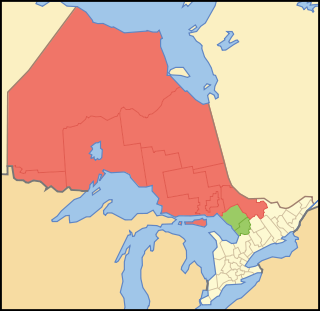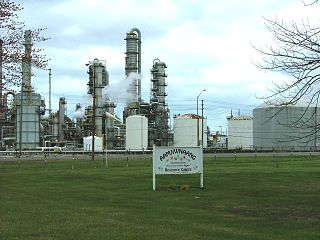Related Research Articles

Anishinaabe traditional beliefs cover the traditional belief system of the Anishinaabeg peoples, consisting of the Algonquin/Nipissing, Ojibwa/Chippewa/Saulteaux/Mississaugas, Odawa, Potawatomi and Oji-Cree, located primarily in the Great Lakes region of North America.

Northern Ontario is a primary geographic and quasi-administrative region of the Canadian province of Ontario, the other primary region being Southern Ontario. Most of the core geographic region is located on part of the Superior Geological Province of the Canadian Shield, a vast rocky plateau located mainly north of Lake Huron, the French River, Lake Nipissing, and the Mattawa River. The statistical region extends south of the Mattawa River to include all of the District of Nipissing. The southern section of this district lies on part of the Grenville Geological Province of the Shield which occupies the transitional area between Northern and Southern Ontario. The extended federal and provincial quasi-administrative regions of Northern Ontario have their own boundaries even further south in the transitional area that vary according to their respective government policies and requirements. Ontario government departments and agencies such as the Growth Plan for Northern Ontario and the Northern Ontario Heritage Fund Corporation define Northern Ontario as all areas north of, and including, the districts of Parry Sound and Nipissing for political purposes, and the federal but not the provincial government also includes the district of Muskoka.

The Humber River is a river in Southern Ontario, Canada. It is in the Great Lakes Basin, is a tributary of Lake Ontario and is one of two major rivers on either side of the city of Toronto, the other being the Don River to the east. It was designated a Canadian Heritage River on September 24, 1999.

The Wiikwemkong First Nation is a First Nation on Manitoulin Island in Northern Ontario. The Wiikwemkong Unceded Territory is the First Nation reserve in the northeast of Manitoulin Island in Manitoulin District, Ontario, Canada. Wiikwemkong is an unceded Indigenous reserve in Canada, which means that it has not "relinquished title to its land to the government by treaty or otherwise."

The Aamjiwnaang First Nation is an Anishinaabe (Ojibwe) First Nations Band located on reserve land by the St. Clair River in Ontario, Canada, three miles south of the southern tip of Lake Huron. The reserve is located across from the United States border from Port Huron, Michigan, and is a result of treaties that were negotiated with the Crown in the 1820s. There are approximately 2,000 band members with about 650 living on the reserve. Their heritage language is Ojibwe.

Gull Bay First Nation or Kiashke Zaaging Anishinaabek is an Anishinaabe (Ojibway) First Nation band government located in Thunder Bay District in northwestern Ontario, Canada. It is approximately 175 kilometres (109 mi) north of Thunder Bay, Ontario on Highway 527 on the western shore of Lake Nipigon. As of May 2010, the First Nation had a registered population of 1,149 people, including an on-Reserve population of 328.

Shingwauk Kinoomaage Gamig is a Canadian Indigenous-led institute, with Algoma University in Sault Ste. Marie as one of its main partners. Shingwauk Kinoomaage Gamig is one of nine Indigenous institutes in Ontario's post-secondary system and collaborates with other colleges and universities to offer post-secondary programs geared specifically toward Indigenous students.

Christi Marlene Belcourt is a Canadian visual artist and author. She is best known for her acrylic paintings which depict floral patterns inspired by Métis and First Nations historical beadwork art. Belcourt's work often focuses on questions around identity, culture, place and divisions within communities.

Michipicoten Island is an island in Ontario, Canada, in the northeastern part of Lake Superior, about 175 kilometres (109 mi) northwest of Sault Ste. Marie and 65 kilometres (40 mi) southwest of Wawa, Ontario. At its closest point to mainland Ontario, the island is located about 16 kilometres (9.9 mi) from the mainland. It falls within the boundaries of Thunder Bay District. The third largest island in Lake Superior, after Isle Royale and St. Ignace Island, Michipicoten Island is 27 kilometres (17 mi) long and 10 kilometres (6.2 mi) wide at its widest point.
Iskatewizaagegan #39 Independent First Nation, also known as Shoal Lake #39, is an Ojibwa/Anishinaabe First Nation, that is part of the Bimose Tribal Council, and subsequently part of Grand Council Treaty 3. It is located along the northwestern shores of Shoal Lake, Ontario, 16 km (9.9 mi) south of Ontario Highway 673.
Raven Davis is a multimedia Indigenous artist, curator, activist, and community organizer of the Anishinaabe (Ojibway) Nation in Manitoba. Davis's work centers themes of culture, colonization, sexuality, and gender and racial justice. Davis currently lives in Halifax, Nova Scotia and works between Halifax and Toronto, Ontario. Davis is also a traditional dancer, singer, and drummer.

Water protectors are activists, organizers, and cultural workers focused on the defense of the world's water and water systems. The water protector name, analysis and style of activism arose from Indigenous communities in North America during the Dakota Access Pipeline protests at the Standing Rock Reservation, which began with an encampment on LaDonna Brave Bull Allard's land in April, 2016.
Josephine Mandamin was an Anishinaabe grandmother, elder and founding member of the water protectors movement.
Tanya Talaga is a Canadian journalist and author of Anishinaabe and Polish descent. She worked as a journalist at the Toronto Star for over twenty years, covering health, education, local issues, and investigations. She is now a regular columnist with the Globe and Mail. Her 2017 book Seven Fallen Feathers: Racism, Death, and Hard Truths in a Northern City was met with acclaim, winning the 2018 RBC Taylor Prize for non-fiction and the 2017 Shaughnessy Cohen Prize for Political Writing. Talaga is the first woman of Anishinaabe descent to be named a CBC Massey Lecturer. She holds honorary doctorates from Lakehead University and from Ryerson University.
Joanne Robertson Misko Anungo Kwe (Red Star Woman) is an Anishinaabe author, illustrator, and water protection activist. Joanne is a member of Atikameksheng Anishnawbek and is of the Bald Eagle clan.
Autumn Peltier is an Anishinaabe Indigenous rights advocate from the Wiikwemkong First Nation on Manitoulin Island, Ontario, Canada. She was named Chief Water Commissioner for the Anishinabek Nation in 2019. In 2018, at the age of thirteen, Peltier addressed world leaders at the United Nations General Assembly on the issue of water protection.
Deborah B. McGregor (Anishinaabe) is a Canadian academic and environmentalist. She is an associate professor and Canada Research Chair in Indigenous Environmental Justice at Osgoode Hall Law School. In 2023, the University of Calgary announced that McGregor had been awarded a Canada Excellence Research Chair at their institution. The start date remains to be announced.

Restoule v Canada is a legal case in the Ontario Superior Court of Justice that considers whether the Augmentation clause in the 1850 Robinson Treaties entitles the Anishinaabe to an increase in annuity payments.
Tasha Beeds is a Plains Cree, Scottish-Metis and Bajan academic. She is a Mide-Kwe and a Water Walker. She was the Ron Ianni Fellow at the University of Windsor's Faculty of Law in from 2020 to 2022; she still guest lecturers for the Indigenous Legal Orders Institute. She was also the inaugural Indigenous scholar at the Anako Indigenous Research Institute at Carleton University. Of note, Tasha also has an invisible disability from a car accident where she suffered a traumatic brain injury. Instead of being impeded by the disability, she promotes seeing the challenges through the lens of Indigenous knowledges where challenges aren't necessarily given labels; instead they are seen as potential opportunities and gifts.

Lynn Gehl is an Algonquin Anishinaabe-kwe from the Ottawa River Valley, Ontario, Canada. She is a writer, blogger and Indigenous human rights advocate. Gehl was involved in legal challenges aimed at eliminating the continued sex discrimination in the Indian Act. She is also an outspoken critic of the contemporary land claims and self-government process, as well as Indigenous issues in Canada. In April 2017, Gehl was successful in defeating Indian and Northern Affairs Canada’s unstated paternity policy when the Court of Appeal for Ontario ruled the sex discrimination in the policy was unreasonable.
References
- ↑ King, Miriam (June 27, 2014). "Mother Earth Water Walk around local lakes sending a message". thebarrieexaminer.com. Barrie Examiner. Retrieved June 20, 2016.
- ↑ "The Women Who Walk for the Water: Grandmother Josephine Mandamin's Legacy". Water Docs. Retrieved 2021-06-17.
- 1 2 Ashawasegai, Jennifer (2011). "Grandmother walks to protect water". www.ammsa.com. Ontario Birchbark. Retrieved June 30, 2016.
- ↑ "Walking for Water | On the Commons". www.onthecommons.org. Retrieved 2021-06-17.
- ↑ "Ojibwe Grandmother and Water Walker Josephine Mandamin Honored for Conservation". Indian Country Today Media Network. May 3, 2016. Retrieved June 20, 2016.
- ↑ "'It's really very crucial right now': Great Lakes Water Walk focuses on protecting 'lifeblood' | CBC News". CBC. Retrieved 2018-04-10.
- ↑ Brown, Lynne. "'The Water Walker'. A Book inspired by Nibi | SaultOnline.com". saultonline.com. Retrieved 2018-04-10.
- ↑ "Trekking the Great Lakes on foot to raise awareness about water pollutants | CBC News". CBC. Retrieved 2018-04-10.
- ↑ Alexander, Jeff (April 22, 2016). "Menominee River Walk raises attention to proposed mine". WBAY.com. Archived from the original on June 1, 2016. Retrieved June 20, 2016.
- ↑ Kaeding, Danielle (September 20, 2016). "Menominee Tribe Organizes Opposition To 'Back Forty' Mine As Project Nears Approval". Wisconsin Public Radio. Retrieved 2017-10-19.
- ↑ "Water Song: Indigenous Women and Water - The Solutions Journal". The Solutions Journal. Retrieved 2018-03-14.
- ↑ "Ojibwe Grandmother and Water Walker Josephine Mandamin Honored for Conservation - Indian Country Media Network". indiancountrymedianetwork.com. Retrieved 2018-03-14.
- ↑ "Award-winning First Nations elder 'will go any lengths for the water'". CBC News. Retrieved 2018-03-14.
- ↑ "UNION OF ONTARIO INDIANS – Grandmother receives Ontario award for taking care of the water". www.anishinabek.ca. Retrieved 2018-03-14.
- ↑ Brown, Lynne. "Josephine Mandamin, Sacred Water Walker receiving prestigious award | SaultOnline.com". saultonline.com. Retrieved 2018-03-14.
- ↑ "The Ontario Heritage Trust". Ontario Heritage Trust. Retrieved 2018-03-14.
- ↑ "Water and Indigenous Activism | Calgary Institute for the Humanities | University of Calgary". arts.ucalgary.ca. Retrieved 2018-03-14.
- ↑ "Media Release: 2015 Conservation Award Winners - Lake Simcoe Region Conservation Authority". www.lsrca.on.ca. Retrieved 2018-03-14.
- ↑ LeMay, Konnie (2011-09-22). "2011 Achievement Award: Walking for Water". Lake Superior Magazine. Retrieved 2018-03-14.
- ↑ "Earth Day Canada Earth Ball". earthday.ca. Retrieved 2018-03-14.
- ↑ "Honouring Grandmother Josephine Mandamin « New College – University of Toronto". www.newcollege.utoronto.ca. Retrieved 2018-03-14.
- ↑ "Ontario Native Women's Association" (PDF).
8. McGregor, Debra (September 2012). “Traditional Knowledge: Considerations for protecting Water in Ontario”. https://ir.lib.uwo.ca/cgi/viewcontent.cgi?article=1080&context= The International Indigenous Policy Journal, Volume 3, Issue 3, Article 11